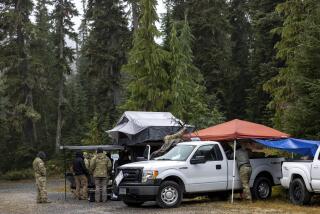Pioneers of Women Airforce Service Proved Sky Is No Limit : Aviation: As nation’s first female military fliers, they freed men for overseas duty in World War II. But WASPs were not acknowledged as part of the service until 1977.
- Share via
BALTIMORE — When Iola Magruder was 15, she took $4 from her piggy bank to treat herself and a niece to their first airplane ride. It was so thrilling that they ran back and got another $4.
From that moment, the young Maryland farm girl knew she wanted to fly.
She got her wish during World War II, when she became a WASP.
The WASPs--Women’s Airforce Service Pilots--were the nation’s first female military pilots, although the federal government did not acknowledge them as such until 1977.
The female civilian pilots were used by the Army Air Force to free men for overseas duty. They flew domestic missions--ferrying planes, hauling gunnery targets, transporting cargo, serving as instructors, testing overhauled aircraft and acting as aerial gofers if a delivery had to be made.
As a group, the WASPs flew nearly every type of plane in the nation’s arsenal--from trainers to the biggest bombers--logging 60 million miles.
“What people like the WASPs did is they laid the groundwork, showing the capability that women could do things in aviation,” said Linda DuMoulin, a retired lieutenant colonel from Alexandria, Va. “We were capable of flying and handling equipment.”
All WASPs had flight training before joining the program. More than 25,000 women applied; only 1,830 were accepted and 1,074 graduated from flight school, located for most classes in Sweetwater, Tex.
It was a heady life for women who had been nurses, teachers, debutantes, secretaries and housewives, many of whom had to cajole parents, even husbands, to join.
“It was an adventure,” said former WASP Winifred Wood of Idlewild, Calif., whose niece is U.S. Atty. Gen. Janet Reno.
“It was such a different life,” said Wood, who learned to fly in a seaplane. “I had never much been away from Florida and Georgia. I went to Texas where it was dry and hot. I had never flown a land plane.”
She wrote a book about her experiences, “We Were WASP.”
“That was my favorite book,” said Reno. “I still have the copy I had as a child in my apartment in Washington.”
Reno grew up hearing tales from her aunt and other WASPs.
“They taught me you can do anything you want to do if it’s the right thing to do. You can defend your country, or do anything,” she said.
WASP missions and training were not without danger; 38 women died. Since they were technically civilians, they were not entitled to death benefits.
Ann Darr of Chevy Chase, Md., who now teaches writing at American University in Washington, D.C., was stationed in Las Vegas when a fellow WASP was shot down and killed while towing a target for gunnery practice.
“We took up a collection because the Army said they were not responsible,” she said. “Civil service said they were not responsible. I was so humiliated that our government could treat us that way.
“I became a feminist the day we took up the collection in Las Vegas to send the body home.”
Still they flew, and loved it.
“I always just liked being up there in the air and flying around like an eagle, especially flying above the clouds. It looks like heaven up there,” said Magruder.
The Women’s Airforce Service Pilots was formed out of two groups created in 1942: the Women’s Auxiliary Ferrying Squadron, a cadre of experienced pilots, which got its start at New Castle Army Air Base near Wilmington, Del., under Nancy Harkness Love, and a women’s military pilot training program, directed by Jacqueline Cochran.
After the two merged in 1943, the mixture never really settled well. Love and Cochran were accomplished aviators of different backgrounds and temperament, each protective of her turf. Love worked to create a squadron of skilled ferry pilots. Cochran wanted to prove women with less experience could be trained to fly as well as men. Her goal was a women’s air corps.
By the end of 1944, male pilots began returning home in increasing numbers. And the Army’s use of female pilots never won the favor of the wartime Congress. Lawmakers rejected legislation that would have allowed the Army to commission the WASPs as officers.
The organization was decommissioned on Dec. 20, 1944. Not until November, 1977, did Congress pass legislation that gave the secretary of defense authority to grant them military recognition, which came in 1979.
Some tears were shed when the WASPs’ wings were clipped. Some women volunteered to fly for free, Wood said.
“But they couldn’t do that,” she added.
Ethel Finley, of Rehoboth Beach, Del., president of the Women Airforce Service Pilots, WWII--a nonprofit group of former WASPs--is philosophical about the group’s unceremonious end.
“To me, World War II was the point where women broke out of traditional roles in general,” she said. “The flying field was perhaps the most non-traditional. They didn’t know what to do with us.
“It started out as an experiment, and it worked. They found that we could do it.
“I don’t think the military or the public were quite ready to accept it, but it laid the groundwork for what women are doing now.”
More to Read
Sign up for Essential California
The most important California stories and recommendations in your inbox every morning.
You may occasionally receive promotional content from the Los Angeles Times.













